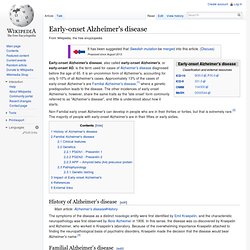

Alzheimer's Association. Fisher Center for Alzheimer's Research Foundation. Alzheimer Research Forum. Alzheimer's Disease International. Beta amyloid. Amyloid-beta (Aβ or Abeta) denotes peptides of 36–43 amino acids that are crucially involved in Alzheimer's disease as the main component of the amyloid plaques found in the brains of Alzheimer patients.

The peptides result from the amyloid precursor protein (APP), which is being cut by certain enzymes to yield Aβ. Aβ molecules can aggregate to form flexible soluble oligomers which may exist in several forms. It is now believed that certain misfolded oligomers (known as "seeds") can induce other Aβ molecules to also take the misfolded oligomeric form, leading to a chain reaction akin to a prion infection. The seeds or the resulting amyloid plaques are toxic to nerve cells. The other protein implicated in Alzheimer's disease, tau protein, also forms such prion-like misfolded oligomers, and there is some evidence that misfolded Aβ can induce tau to misfold.[2] A recent study suggested that APP and its amyloid potential is of ancient origins, dating as far back as early deuterostomes.[3]
Tau protein. Tau proteins (or τ proteins, after the Greek letter by that name) are proteins that stabilize microtubules.

They are abundant in neurons of the central nervous system and are less common elsewhere, but are also expressed at very low levels in CNS astrocytes and oligodendrocytes.[1] Pathologies and dementias of the nervous system such as Alzheimer's disease can result when tau proteins become defective and no longer stabilize microtubules properly. The tau proteins are the product of alternative splicing from a single gene that in humans is designated MAPT (microtubule-associated protein tau).[2][3] They were discovered in 1975 in Marc Kirschner's laboratory at Princeton University.[4] Function[edit] Tau protein is a highly soluble microtubule-associated protein (MAP).
In humans, these proteins are found mostly in neurons compared to non-neuronal cells. Tau proteins interact with tubulin to stabilize microtubules and promote tubulin assembly into microtubules. Structure[edit] Alzheimer's disease. Early-onset Alzheimer's disease. Early-onset Alzheimer's disease, also called early-onset Alzheimer's, or early-onset AD, is the term used for cases of Alzheimer's disease diagnosed before the age of 65.

It is an uncommon form of Alzheimer's, accounting for only 5-10% of all Alzheimer's cases. Approximately 13% of the cases of early-onset Alzheimer's are Familial Alzheimer's disease,[1] where a genetic predisposition leads to the disease. The other incidences of early onset Alzheimer's, however, share the same traits as the 'late onset' form commonly referred to as "Alzheimer's disease", and little is understood about how it starts. Non-Familial early onset Alzheimer's can develop in people who are in their thirties or forties, but that is extremely rare.[2] The majority of people with early-onset Alzheimer's are in their fifties or early sixties. History of Alzheimer's disease[edit] Familial Alzheimer's disease[edit] Clinical features[edit] Genetics[edit] PSEN1 - Presenilin 1[edit] PSEN2 - Presenilin 2[edit] References[edit]